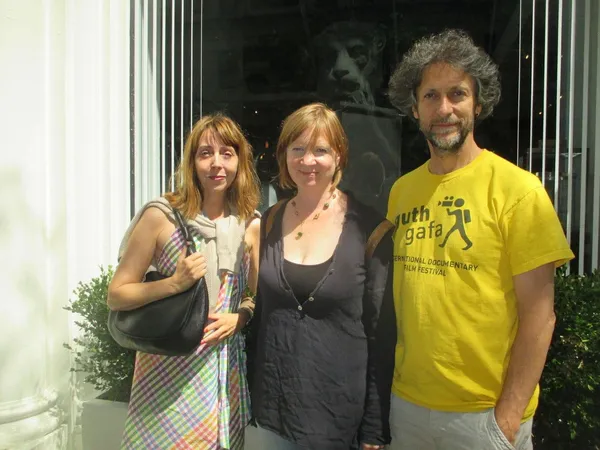"Who controls the past controls the future. Who controls the present controls the past," George Orwell logged in his 1984. This quote, as well as an image of the strolling, memorising book people - Julie Christie and Oskar Werner among them - from François Truffaut's film adaptation of Ray Bradbury's science fiction novel Fahrenheit 451 came to my mind while watching Neasa Ní Chianáin and David Rane's remarkable, enchanted documentary School Life (In Loco Parentis) that kidnaps us into a world-building realm of unlimited imagination.
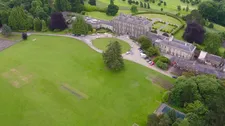 |
| Headfort School in Ireland: "It's an 18th century house and it has all that wonderful flavour of Harry Potter…" |
At the Ace Hotel off Broadway in New York, the directors shared with me behind-the-scenes stories of Headfort School instructors Amanda and John Leyden, Headmaster Dermot Dix, and the children who thrive in an environment that inspires them to explore thought, music, drama, animals, books.
In School Life, we enter a private primary boarding school in Ireland, housed in the 18th century ancestral estate of Headfort, and never leave. Shot in vérité style by Neasa Ní Chianáin, everyday occurrences - lessons, band practice, games in the forest, sports - unfold like a puzzling new universe for any incoming student.
Anne-Katrin Titze: I'd like to start with the first scene. There is a dog on the table. It is the size of a calf. How you introduce the couple, John and Amanda, is great. It's so matter-of-fact. Anyone with pets [who like to take over the dining table] can relate. How did this shot come about as the introduction to a film about education?
Neasa Ní Chianáin: We needed to establish that the film is about John and Amanda and that these were the two people who were going to guide you through the year, the academic year. We also wanted it to be a little mysterious in the beginning so you didn't really know where you were going to be taken. And in their world, dogs are as important as humans. So it was just very fitting that that scene introduced them.
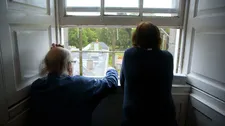 |
| On John and Amanda Leyden: "And the smoking window, that was the moment they would escape to in between classes." |
AKT: Another thing you introduce about them, right from the beginning, is the smoking. Several times throughout the film we see them together in the school, leaning out of a window, smoking. They don't smoke in front of the children, I suppose?
David Rane: No, they never smoke in front of the children. But they are chain-smokers. So when we were filming with them without the children, they were always smoking. As you know, we work observationally, so it would be completely wrong to say "John, Amanda, please don't smoke!" We had to let them be themselves and be natural and that's who they are.
NNC: And the smoking window, that was the moment they would escape to in between classes. That's where they catch up with each other on what was happening during their day.
AKT: Those moments become the chorus of the film to explain to us where we are, too. It made me think about something I never really thought about concerning educators. It's like artists. You love their work. You may think Beckett is the greatest writer ever. But Beckett the person, may be not so perfect. Here, the "product", the children, are so wonderful. Yet, they [John and Amanda] are chain-smokers.
DR: There is an imperfection in that perfect world, yeah.
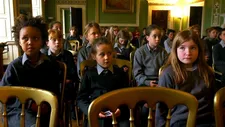 |
| Headfort School students at assembly: "We filmed for two years. It was just the two of us. Neasa was doing the cinematography and I was doing sound." |
AKT: I appreciated your showing of this. Can you talk about the background of the school, as it isn't mentioned in the film?
NNC: The school was started in 1949 by Lady Headfort. It's sort of from that colonial era in Ireland. A lot of families were struggling at that time to maintain these massive houses. They came up with starting a school because there was a need for children from the Anglo-Irish world to have a primary school in Ireland. And most of them would go on to British schools. So this is a preparatory school.
AKT: What is the age bracket?
NNC: Seven to 13.
DR: It would have been an ancestral home of Lord Headfort and would have gone through generations of being owned by the aristocracy in Ireland. It was the 1760s, I think, when it was built. It's an 18th century house and it has all that wonderful flavour of Harry Potter and the lovely long corridors and the winding staircases. It's not in our film, but there's even a secret door in the Headmaster's office.
AKT: Of course.
DR: Of course. Inevitably, a bookcase that opens mysteriously.
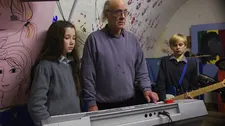 |
| John Leyden with Eliza and Archie at band practice |
AKT: And a painting hiding it, too, probably. Who are the students mostly?
NNC: It's a mix. There are some from the Anglo-Irish community in Ireland and a lot of middle class children. From all around the country children that don't have access maybe to that kind of school where they live. There's international students as well, maybe 30 to 40% are international. They have a cap on the international students because they want it to be fundamentally an Irish school with international kids coming in. Also Dermot, the headmaster, he would consider himself a Marxist, so he also provides a bursary for families that can't afford the full fees. That varies from year to year how many he can take in.
AKT: What was the timeframe you show of the school?
NNC: September 2014 to 2015.
DR: We filmed for two years. It was just the two of us. Neasa was doing the cinematography and I was doing sound. But when it came up to the editing stage, we decided, just for chronology and because the children had changed from one year to the next - we decided only to use the second year in our film.
AKT: You have become clearly a part of the school. Were you living there? Your children as well?
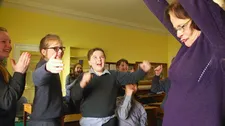 |
| Amanda Leyden with Aurora, Willa, Ted, and the Upper Fifth class |
NNC: Yeah, we had a room. Our children went there as day pupils.
DR: While we were working there, because we went to school every day, we were like children. We had a room in the school where we kept our cameras and sound equipment and had cups of tea. It meant we were ever-present. We could respond to things that were happening and just get a sense of the school.
AKT: There seem to be no barriers between you and the children.
NNC: Almost none. The children were amazing, they really let us into their circle. You work intuitively and you knew when you weren't welcome. And that only really happened at the end of the summer term with the little romances - and when I'm talking about romances, I'm talking of, like, the most innocent of romances - would start. So if the girls were talking about boys we were never really allowed into that conversation.
DR: Children between about seven and about 11 and 12 are remarkably innocent and relaxed. They forgot about us. We became the fly on the wall. They trusted us and it helped that we were parents as well.
 |
| Florrie in the band room of Headfort School with gap year student Olivia |
AKT: For your approach, were there any filmmakers you had in mind, were you saying - this is where we want to go as well with this film?
DR: Definitely. We're both big, big fans of observational, you know, direct cinema, cinéma vérité. We would watch Pennebaker films, Wiseman films, Maysles brothers. Some of the European filmmakers, like Kim Longinotto. We were big fans of that form. We decided right from the start that we wanted to do it observationally and to be as pure as we could possibly be.
AKT: Which means no names, no placards explaining anything.
NNC: No, we fought against all that.
DR: People who watched some early cuts said: "Maybe you need to just put up that this is the last private primary boarding school in Ireland - just as a card?" And we resisted it. I'm kind of glad we did because I think it does feel like you've dropped the audience into that world. You started out asking about that opening scene - the audience just lands in Headfort and they're there. And then slowly this world unravels.
AKT: As it would be for one of the children.
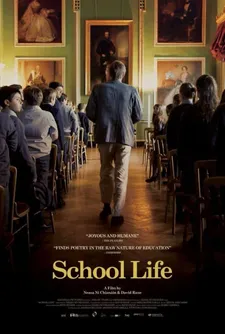 |
| School Life US poster |
NNC: Exactly.
AKT: We ask ourselves - Who are these people? What are the rules? Let's take the forts, for example. Almost every child can identify with that. And the rules say - you can play, but not World War III. I liked very much when and how the rules came into play. Also the kinds of questions in the classroom you chose to show. "Where is God?" is one of them. "What do you think of same-sex marriage?" is another question posed to the kids.
DR: Which is quite an unusual question for ten-year-olds! That class was 9-, 10-year-olds on same-sex marriage. I think Dermot Dix as a headmaster, he really encourages the children to ask questions and debate and discuss.
NNC: He taught here [in New York] at the Dalton School before he went back to Headfort to teach.
AKT: Because he was a student there himself in the Seventies?
NNC: Yes, he was a student at Headfort.
DR: Taught by John and Amanda!
NNC: And stayed in touch with John and Amanda all through his study and career. That's who they are, John and Amanda. They do stay in touch with all these children. 50, 40, 30-year-olds. You can go to their house any weekend and somebody will be there visiting from their past.
DR: They still call him [the Headmaster] "one of our kids." I think it was John who contacted him and said "Dermot, the headmaster job has come up." This was twelve years ago. So he went full circle.
AKT: He is the one who brings up Gandhi. That's a great moment when he tells the students that when the rules are immoral, you should break them. That's good advice for ten-year-olds. Or even the seven-year-olds.
NNC: Yeah, we loved being in Dermot's classes because they were always inspired. We were kind of hanging on every word he was saying as well.
Coming up - Neasa Ní Chianáin and David Rane on the children's favorite season, moments of chaos and order, some remarkable transformations, and casting the "net as widely as possible" in School Life.
School Life opens in the US on September 8.
School Life will open at London's Bertha DocHouse on October 13 with Neasa Ní Chianáin and David Rane participating in a post-screening Q&A.








